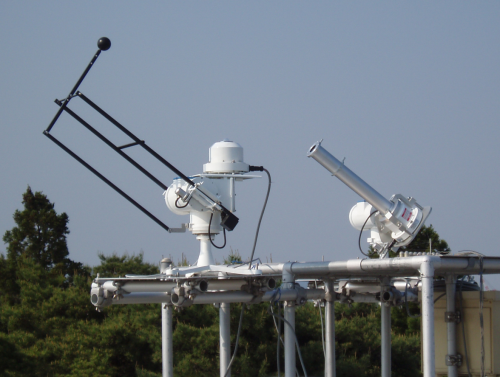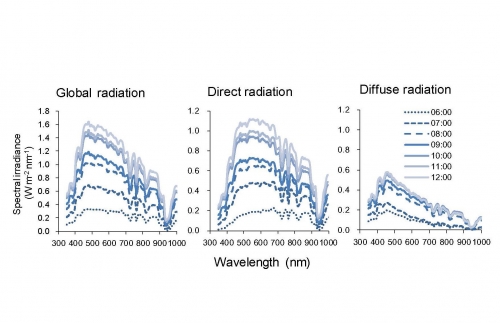研究成果 Research Results
- TOP
- News
- Research Results
- Leaf color is fine-tuned on the solar spectra to avoid strand direct solar radiation.
Leaf color is fine-tuned on the solar spectra to avoid strand direct solar radiation.
2016.03.15Research ResultsLife & HealthEnvironment & Sustainability
The spectral distributions of light absorption rates by intact leaves are notably different from the incident solar radiation spectra, for reasons that remain elusive. Incident global radiation comprises two main components; direct radiation from the direction of the sun, and diffuse radiation, which is sunlight scattered by molecules, aerosols and clouds. Both irradiance and photon flux density spectra differ between direct and diffuse radiation in their magnitude and profile.
However, most research has assumed that the spectra of photosynthetically active radiation (PAR) can be averaged, without considering the radiation classes. We used paired spectroradiometers to sample direct and diffuse solar radiation, and obtained relationships between the PAR spectra and the absorption spectra of photosynthetic pigments and organs.
As monomers in solvent, the spectral absorbance of Chl a decreased with the increased spectral irradiance (W m-2 nm-1) of global PAR at noon (R2 = 0.76), and was suitable to avoid strong spectral irradiance (λmax = 480 nm) rather than absorb photon flux density (μmol m-2 s-1 nm-1) efficiently. The spectral absorption of photosystems and the intact thallus and leaves decreased linearly with the increased spectral irradiance of direct PAR at noon, where the wavelength was within the 450-650 nm range (R2 = 0.81). The higher-order structure of photosystems systematically avoided the strong spectral irradiance of direct PAR at noon. However, when whole leaves were considered, leaf anatomical structure and light scattering in leaf tissues made the leaves grey bodies for PAR and enabled high PAR use efficiency. Terrestrial green plants are fine-tuned to spectral dynamics of incident solar radiation and PAR absorption is increased in various structural hierarchies.

Solar tracking spectroradiometers set atop the NIES building (36.05°N, 140.12°E) in Tsukuba, central Japan. Two grating spectroradiometers (MS-700; EKO Instruments Co. Ltd., Tokyo, Japan), fixed to sun trackers (STR-22G-S; EKO Instruments Co. Ltd.), with one equipped with a collimation tube (angle of view 5°), and the other with a shadow ball.

An example of clear-sky spectral irradiance. These were measured on a clear-sky day (day of year = 195) in 2011, and averaged over each hour. Measurements were conducted at 1-min intervals during daylight, atop the National Institute for Environmental Studies building (36.05° N, 140.12° E). Spectral range was 350–1050 nm and spectral interval was 3.33 nm.

Relationships between spectral irradiance of direct PAR at noon and (a) spectral absorbance of purified LHCII trimer and PSI-LHCI and (b) spectral absorbance of leave (Ulva, Oryza, Quercus). The graphs are plotted with spectral absorbance or absorptance on the y-axis and the spectral irradiance on the x-axis at 3.35-nm intervals in the 400- to 680-nm bandwidth. The points with consecutive wavelength are connected with a line. The points with the shortest (400 nm) and longest wavelengths (680 nm) are indicated by a square and a cross, respectively.
Researcher comments
The waveband of the green region was identical to that of strong directional solar irradiance, during midday hours under clear-skies. Spectral filtering is a robust and steady way of reducing excess energy absorption by photosynthetic pigments.
We have shown that terrestrial green plants are fine-tuned to spectral and temporal dynamics of incident solar radiation. Further field observation and analyses of spectral and temporal dynamics of incident solar radiation are needed to understand the spectral adaptation of terrestrial organisms.
Journal Reference
Leaf color is fine-tuned on the solar spectra to avoid strand direct solar radiation, ,Atsushi Kume, Tomoko Akitsu and Kenlo Nishida Nasahara, Journal of Plant Research , 10.1007/s10265-016-0809-0Research-related inquiries
- TOP
- News
- Research Results
- Leaf color is fine-tuned on the solar spectra to avoid strand direct solar radiation.































